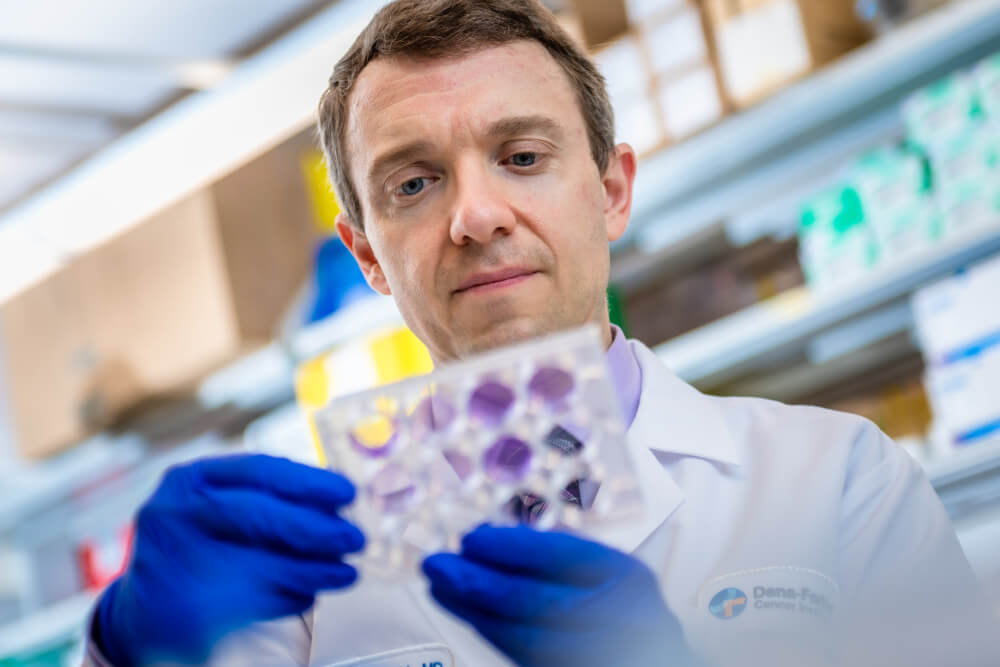At 28 years old, Dana-Farber bioinformatics analyst Carino Gurjao is already making a splash in the field of colorectal cancer research.
He is coming off the back of a big year: The Paris-born researcher was named to Forbes Healthcare’s 2022 30 Under 30 list for his role in the Giannakis Lab at Dana-Farber, which identified a mutational link between red meat and colorectal cancer.

A young graduate moves to the United States
Gurjao’s foray into cancer research began in the city where he grew up: Paris.
“I’ve been interested in nature and biology since I was very young,” he says.
He entered an undergraduate program that was focused on biology and math, not wasn’t sure whether he wanted to pursue a clinical career or focus on analytics. Bioinformatics was a rapidly growing field when it came time for Gurjao to choose what to pursue in his graduate studies, so he enrolled in a bioinformatics master’s program.
“There was a huge need for people that could understand biology and computational and mathematical tools,” he says.
Gurjao was always interested in cancer research, but that interest was further confirmed when he took on an internship at the Curie Institute in Paris. Soon after, in 2016, Gurjao became involved in an immunotherapy research project at the Massachusetts Institute of Technology (MIT) and quickly fell in love with the city of Boston.
“The fact that Boston is so focused on biology and healthcare makes it the perfect place for me,” he says. “There are so many interesting people to meet and so many ongoing projects.”
Applying research to clinical practice
Although the work at MIT was interesting, it was mostly theoretical, and Gurjao wanted to get involved in projects that could be applied to clinical practice and patient care. When an opportunity came to work at Dana-Farber under Marios Giannakis, MD, PhD, Gurjao couldn’t pass it up.
“It’s rewarding to see work that is applied and to work with and for people that are directly patient facing,” he says. “At the Giannakis lab, I am working with a very large cohort of colorectal patients with rich clinical information.”

In the study in which Giannakis, Gurjao, and the other collaborators, identified a DNA damage imprint linked to red meat intake Carino drew from thousands of patients’ genetic and lifestyle data that had been collected since the 1970s. He analyzed patterns of DNA mutations called “mutational signatures” and observed that a specific pattern was more abundant in tumors from patients who consumed a lot of red meat compared to the rest.
“It was really cool to map those two groups of information and to see how they integrate,” Gurjao says. “Red meat was suspected as a mutagenic factor for a long time, but it wasn’t fully confirmed because we simply didn’t have a dataset large and comprehensive enough.”
This work, which was published in the journal Cancer Discovery, can have important preventive implications for colorectal cancer.
In his next project, Gurjao will be partnering with researchers at Columbia University to study colorectal cancer across ethnicities.
An exciting field at an exciting Institute
After four years at Dana-Farber, Gurjao feels just as excited as he did when he first joined the team.
“Everyone that I work with is incredibly ambitious and passionate,” he says.
He’s an important part of the team: As an analyst, Gurjao is a kind of translator, one that can speak the language of biologists and mathematicians.
“Surprisingly, my work is very social,” he says. “I have to meet with multiple disciplines to work out the underlying biology at work in a project. The environment at Dana-Farber has been incredible for that. I am able to work with experts in every field. For the red meat project, for example, we were able to work with researchers ranging from pathologists to epidemiologists to geneticists.”
Gurjao also says that with the latest computational and sequencing technologies, it’s an exciting time to be in the bioinformatics field. That drives him to produce the best work possible.
“There are times when I find something that I realize, ‘Wow, I’m the first to see this,’ because that data just hadn’t been generated before.”
